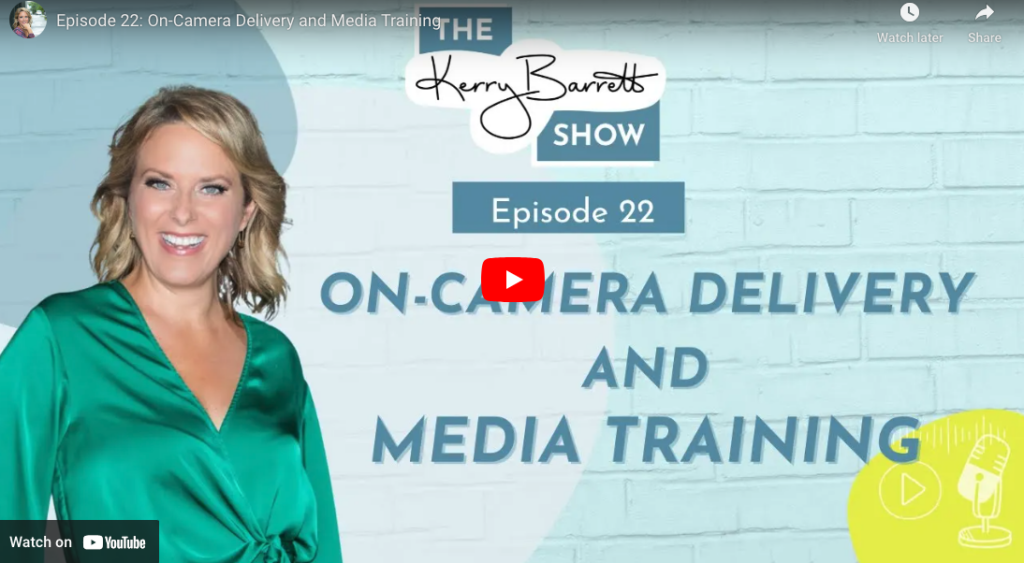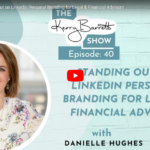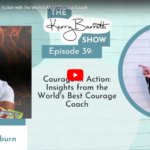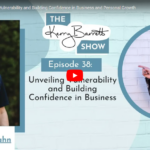
In this episode, Kerry Barrett discusses the importance of on-camera delivery and media training for both marketing and sales purposes. She emphasizes the significance of camera presence on social media platforms, as well as the use of long-form live videos in webinars, podcasts, and masterclasses. Kerry highlights the alarming statistic that 63% of people leave webinars, even if they’ve paid for them, due to the host being boring. She stresses the need for effective presentation skills on camera and mentions that logistical aspects such as lighting, audio, and setting up the shot can be easily fixed once you know how.
Transcript
Kerry: Hi, I’m Kerry Barrett, and thank you for listening to The Kerry Barrett Show. I’m going to talk about it today. On-camera delivery, media training, if you will, video, and showing up on camera are not just for marketing. It is for sales as well.
And certainly, camera presence is absolutely 100 percent needed to show up well on social media, whichever platform you’re going to be on, however, there is nothing like long form.
Kerry: Especially live video to really make you sweat. And where do we use long-form live video? We often use them in the most important part of our customer’s buying journey. And that’s through a webinar or it could be a podcast or a masterclass, certainly a live stream. But webinars are great ways to not just market, but also build trust with your audience and certainly sell as well.
Kerry: Did you know this though? According to a study by Wistia, 63 percent of people leave a webinar, even one that they’ve paid for, because the host is boring.
And so that urgent message that you have to get out there, more than half of your audience, isn’t even seeing it if you’re not delivering it in the right way.
Kerry: And so today I’m going to talk a little bit about some of the tactics that go into presenting well on camera. I’m not going to talk about lighting, I’m not going to talk about audio, I’m not going to talk about setting up your shot. Those are all sorts of logistical things that are covered in my program, VIQ for business owners.
Kerry: But they’re easy fixes. Once you know how to fix them, maybe they require buying a little bit of gear or reframing where you sit in front of your computer, but once you know what you’re looking for and you know what you need, you can fix those things fairly quickly. The part that most of us have trouble overcoming is the part of actually putting your face on the camera and talking to a whole sea of people who are out there that are watching you.
Kerry: Listening to you, judging you, perhaps talking amongst themselves, and that can be intimidating. You know, I overcame a huge fear of not just speaking or being on camera, but really even just being seen. And I went on to have this two-decade career as a news anchor in New York City, won a couple of Emmys as well.
Kerry: So, I know absolutely 100 percent that if I can do it, you can absolutely do it. 100 percent do it as well. It’s just a matter of knowing what the skills are, knowing how to implement them, and then practicing. Now that may sound like a lot, or maybe it doesn’t sound like all that much to you, but there are some basics of getting in front of the camera and delivering to your audience so that they can.
Kerry: Stick around and hear what it is that you have to say that is universal. It doesn’t matter what platform you want. Doesn’t matter what you are recording. It doesn’t matter whether it’s sales or marketing. There are some basics that are applicable to everyone. The main goal when you are on camera, again, regardless of the reason, is that you want to be memorable and you want to be charismatic so that you can keep people around to the end.
Kerry: You want to deliver them, deliver to them rather, in a way that they can best receive. And so today we’re going to talk about how to MVP your VIQ. That’s my trademarked framework for crafting your online or your on video persona and then delivering in a way that your audience can receive it. The biggest mistake that people make when they’re on camera is that they lack energy and energy doesn’t mean that you have to be this, you know, big giant sort of lots of gestures and wild articulations and all that other sort of stuff.
Kerry: Energy really just means that you have to continue to engage your audience and you have to use all of the tools that you have in your little toolbox, your knapsack in order to do that. And so that means all of those different physical sort of performance things that any speaker on any in person stage would deploy or use in order to gain the attention and keep the attention of the audience.
Kerry: When we get on camera, we have a tendency to sort of shut down. And, if we’re not used to it, you know, decrease our vocal range, and we have a tendency to sit very still, and we’re not exactly sure where to look, because it’s very awkward, and, Most of the time, the people on the other side of the lens, they don’t really know what they’re doing either, so it’s awkward on both sides, but you’re the one that’s leading them sort of through this experience and to the end result or whatever it is that you’re looking to do.
Kerry: So, MVP stands for Mindset. Vocal variety and physical performance and V. I. Q. stand for video. I. Q. So, we’re going to talk about just some basics today of media training. Again, remembering that the goal is to be charismatic, engaging, and definitely memorable. The first thing that we get to is mindset.
Kerry: And I really mean sort of two things when I say mindset. I’m talking about the way that you prepare and show up and deliver and receive when you’re on camera and also the way to think about your audience. Let’s start with the first. The first is. Getting ready to show up and turn that camera on and talk to whomever is on the other side.
Kerry: And I’m going to share a little story with you because when the pandemic hit now, mind you, I had already been on camera in front of live audiences of millions for 20 years. I have been doing this sometimes for, if it was breaking news up to 12 or 14 hours at a stretch. So this is nothing new to me, live video, but I got to tell you when you’re sitting by yourself and I’m not surrounded by my co-anchors and I know that I am doing everything.
Kerry: The first webinar that I delivered after I started my business and the pandemic hit was 45 minutes and I was talking to a smallish group of people. And I got to tell you, by about 10 minutes in, my lips were numb, I felt weird because I didn’t know what anybody on the other side was doing, I couldn’t see them, I couldn’t engage, they could be, I don’t know, you know, not even sitting in front of the computer for all I know.
Kerry: And what I had to rely on at that point, was my comfort with speaking on camera and knowing how to deploy the skills so that I didn’t get in my head about it. And I was able to keep my energy up. Had I not had those skills sort of running on autopilot, I would have gotten in my head. My energy would have decreased because I would have felt like nobody was listening.
Kerry: And so I continued to deliver. Regardless of whether anybody was on the other side of the lens. And in fact, they were, and it got rave reviews and it got me several clients as well. So the mindset is knowing that you can, in fact, show up and you can navigate through whatever happens, and you’re going to come out on the other side, and you’re still going to be standing Had a complete in your mind failure of a webinar or a master class or a live stream or whether you got rave Reviews the fact is that you got through it and there’s always going to be trolls and there’s always going to be people who are looking to take others down but Recognize that you’re the one in the arena you are the one with the blood the sweat and the tears and the people that are watching and What they think of you is none of your business.
Kerry: So that’s mindset number one. And I have to tell you, that is probably the hardest one to get over is to not care what others are thinking because that’s how we’re designed. We’re designed to want to be most of us part of the pack, and we don’t want to be kicked out or judged or. Lose status in the eyes of our peers.
Kerry: That one thing is 100 percent the hardest to get over. What I will also tell you is that you won’t ever get over it until you actually start to do it. You have got to start to show up on camera or video, wherever, before you’re ready. You will never feel ready. Do it before you’re ready. First comes the action, then comes the clarity.
Kerry: The second part of mindset is knowing that, regardless of how many people are watching you, you are always talking to an audience of one. So, whether you are on a livestream, a webinar, a masterclass, whatever it is, you are talking in your mind to one person. And once you recognize that is the best way to connect and you imagine that ideal person or that ideal customer and you are talking just to him or her, you remove yourself sort of out of your own head and you focus on delivering value to that person.
Kerry: And when you start to focus on the audience, everything else elevates organically and what I mean by that is when you realize that the way that you are saying something helps your audience member absorb it, take it in, learn from it, do whatever the next thing is that you want them to do. Once you recognize that and you’re actually doing them a favor by delivering in a way that they can comprehend and they want to stay engaged.
Kerry: Then all of that other stuff begins to elevate because you know that you need to use vocal inflection and you need to change the pace and the pitch and you need to use body gestures and hand gestures and body language is what I meant to say. And facial expressions to bring your audience in.
Kerry: And once you stop thinking about, oh my gosh, what should I be doing with my hands? Or I don’t know where to look or, Oh my gosh, what if nobody’s listening to me? I sound like a fool. I’m talking into a void. Once you get out of that mindset, then you stop worrying about all of that other stuff.
Kerry: And you just start delivering because you know, the person on the other side. wants to hear what it is that you’re saying. And if you make it easy for them to hang with you and stay through, they will. So that’s the mindset. The next thing I want to get to is vocal variety. And vocal variety really is, it’s four Ps.
Kerry: It’s pace, its pitch, it’s pronunciation, and it is. So, let’s start with pronunciation first, because we think it has a tendency, we think it means, rather, that we know how to pronounce words correctly. And certainly, it does. But what people sometimes have a tendency to do… When they’re nervous or they’re trying to get through a script or there, you know, their mind is not focused on delivering to the camera, we start to slur our words.
Kerry: I know it still happens to me. It happens to me if I’m dehydrated. It happens to me if I’m tired. It is one of the things that I always have to stay vigilant about because I will slur my words. So, that’s pronunciation. Make sure that you are speaking as crisply and as clearly as you possibly can. Now, let’s talk about projection.
Kerry: And projection doesn’t mean that you are screaming. Remember, your audience’s ear is right wherever your microphone is, whether you have a lapel mic on or you have an internal mic on your webcam or your computer or you have an external mic. That is literally your audience’s ear. And so you don’t need to scream, but you do need to amplify the way that you talk and you can use projection in a whole bunch of different ways.
Kerry: If you’re looking to gain attention, you may drop the production down or the projection down a little bit because that grabs people’s attention. That is a pattern interrupt. Or you may decide that there’s a particular part that you really want to emphasize. And you project on those words. Now part of that is knowing exactly what you’re going to say, or you have an outline of what you’re going to say.
Kerry: But knowing your material so well that you know which areas you need to emphasize. And which areas and words you need to amplify intentionally. The next is pitch. And pitch is really how high or how low your voice goes. I will tell you this. I have seen keynote speakers who make tons of money who have tiny little squeaky voices.
Kerry: And I’ve seen people with deep baritone dulcet tones who can’t speak in public at all. So, there’s not a lot that you can do to truly change the pitch of your voice. And I never want you to be, you should never aim to be. Somebody that is different from who you are, but recognize that generally speaking, a bit of a lower pitch tends to show authority to your audience.
Kerry: And when we get nervous and we start to have shallow breaths and we’re sort of racing through things, we begin to speak up here and our pitch gets a little bit higher rather than down here where we’re using our full lungs and we’re. Perhaps just making our voice a little bit more resonant. And so be aware that as you’re on a webinar, you may in fact get nervous and you may start to take shallow breaths and you can overcome that.
Kerry: The key is to make sure that you are breathing deeply and that you are monitoring the way that you feel internally. Do you feel nervous? Is your voice shaky? Take a couple of breaths. And then move on with the rest. And then the final P, of vocal variety, is pacing. And pacing is really the rate at which you speak.
Kerry: Generally, we speak at about three words per second. Now that’s just an average, but it’ll give you, if you have something written out, a general idea of how long it’ll take you to say it.




